An eerie portal to the Maya underworld
 Belize Tourism Board
Belize Tourism BoardIn Belize's ATM Cave, details of ancient Maya religious sacrifices come into focus as new research creates a picture of how rituals were used to re-enact the Maya creation story.
In the eerie red glow of head torches, we could see cracked ceramics lying on the cave's damp, clay floor. Our guide shone a white light across stalactites and stalagmites, illuminating broken stone metates – tools used by the Maya to grind corn – and large earthenware pots.
Then the beam caught the sheen of a human skull half-buried in the clay; its front teeth were cracked, and the bone had long-ago crystallised into calcite. This was the Main Chamber of Actun Tunichil Muknal (the ATM Cave) in the jungle of western Belize, and to the Maya, this eerie, fascinating cavern was a sacred entrance to Xibalba, the Maya underworld.
For more than 1,000 years, the 5k-long subterranean ATM Cave system lay unlooted and undisturbed. Locals rediscovered the entrance in 1986, and, shortly after, hydrologist and spelunker Thomas Miller found skeletons inside. In the decades that followed, the unusually pristine ATM Cave became the subject of much study, offering scientists and intrepid travellers a glimpse into Maya religion and society from about 700-900 BCE. From research at this and other sites in Belize, archaeologists knew that the Maya ventured deep into caves to connect with their deities in some way, but the specifics of those ceremonies and rituals – and the reasons for them – remained shrouded in mystery.
Then in 2021, two of the key archaeologists who'd been involved in ATM Cave excavations since the 1990s introduced a new methodology for unravelling those mysteries. In their paper – Sacrifice of the Maize God: Re-creating Creation in the Main Chamber of Actun Tunichil Muknal (a chapter of the anthology research book The Myths of the Popol Vuh in Cosmology, Art, and Ritual) – Professor Holley Moyes from the University of California and Belizean archaeologist Dr Jaime J Awe explained how they'd been able to build an intricate picture of the religious ceremonies by studying the spatial layout of skeletons and artefacts left behind. They could tell where the Maya stood while the ceremonies unfolded, which mythical stories they re-enacted, which gods the Maya impersonated in rituals and how the unlucky were sacrificed.
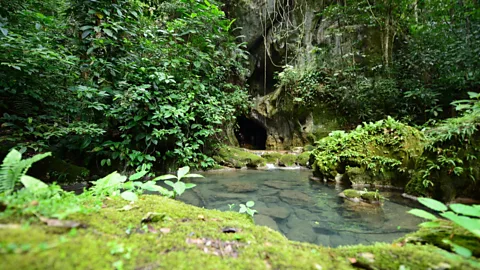 Belize Tourism Board
Belize Tourism BoardThere are no first-hand accounts of what happened in Maya cave ceremonies, but the new theory brings their religious ceremonies to life on a human level that, until now, was not grasped. Moyes and Awe posit that the Maya were staging elaborate, theatrical and deadly re-enactments of the Popol Vuh, the Maya creation myth – and that they were doing it as a way to prompt their gods to force a "rebirth" of the world in the period right before drought and political turmoil brought about the end of their civilisation, known as the Maya Collapse, in the 10th Century.
"It's probably one of the most important archaeological caves in the world, in terms of its level of preservation and archaeological value. Mainly because it wasn't looted," said Moyes. "And it's such an adventurous cave; just getting there you go through the jungle, you go through the water and you get to experience the path the Maya took to go there."
The 8m-high entrance to ATM Cave is hidden behind tangled vines and thick foliage deep in the Tapir Mountain Nature Reserve. The trailhead is a one-hour drive from San Ignacio, a town close to the Guatemalan border. From here, it's a 45-minute walk through the jungle, and over a series of waist-high and knee-deep river crossings to the entrance. Here, the path ends, and the only way into the ATM Cave is to swim.
"The Maya would make this journey with burning torches", said Hector Bol, a guide from the local Maya community, who's been leading tours into the ATM Cave for 18 years. Our small group of five tourists switched on our head torches and left daylight behind as we followed him, wading through the river as it carved a path through the limestone.
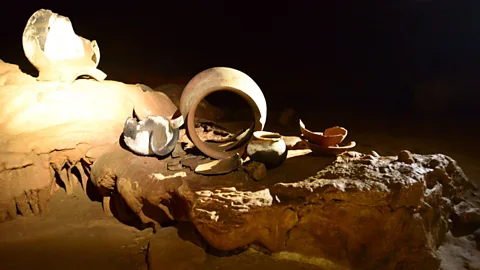 Belize Tourism Board
Belize Tourism BoardCaves are integral to the Maya worldview. "The Maya started using caves around 1200 BCE, when they first started moving into Belize," Moyes later told me. She explained that caves were at the bottom of a three-tiered cosmos, with the terrestrial human world above and the gods in the sky.
When we arrived at the Main Chamber, Bol instructed us to remove our shoes. "You always lose your sole in the Maya underworld," he joked. Using his torch as a pointer, he highlighted clay pots balanced on ledges and heavy stone metateslying in calcified pools on the floor.
When his light picked out the unmistakable outline of that crystallised skull, we were all hushed into silence. Nearly 1,500 objects and fragments have been recorded so far, and 21 human skeletons.
In the Popol Vuh creation myth, two god-like figures known as the Hero Twins journey to the underworld to appease the Lords of Xibalba and challenge them to a ball game. The twins lose and are promptly sacrificed. Another set of Hero Twins then follow to avenge their father (one of the original Hero Twins), and eventually win. Their avenged father is reborn as the Maize God, from whom all human life is then created, and the Hero Twins punish the Lords of Xibalba, who from then on can only receive offerings that are damaged in some way.
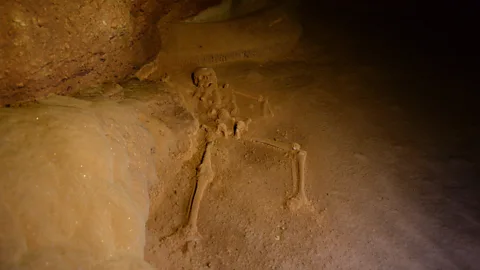 Belize Tourism Board
Belize Tourism BoardEvidence within ATM Cave suggests that it's this myth the Maya were re-enacting in a desperate attempt to battle the Lords of Xibalba, just as the Hero Twins did.
"The Maya must have believed that the evil Lords of Xibalba were triumphing in some way during droughts," Moyes said, referencing the natural disaster that experts believe contributed to the civilisation's downfall. "The Lords of Xibalba aren't allowed to have nice things, and almost everything we find in the ATM cave is broken, which makes me think that these must be offerings for underworld deities."
Moyes also explained how all of the artefacts in ATM Cave have been dated to right before the Maya Collapse. "We have super tight radiocarbon dates. We know this happened in a very short period of time," she said. "All of the ceramics in the cave date between 700-900 [CE]. [The Maya]are in full drought conditions by around 820[CE]. By 850[CE], the area is depopulated, so they are coming into the cave at the height of the drought, right before it's abandoned."
When our tour reached the centre of the Main Chamber, Bol highlighted the small Three Stone Hearth, fashioned by the Maya from three speleothems (mineral deposits found in caves) as a clear reference to the three-stone hearth in the Popol Vuh, on which the Maize God was reborn after being sacrificed.
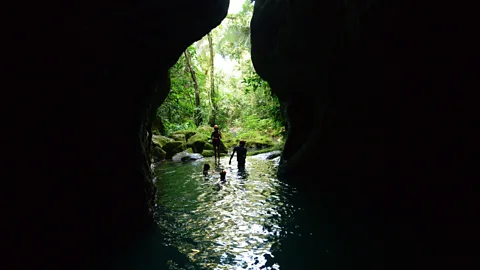 Belize Tourism Board
Belize Tourism Board"There are a number of artefacts, as well as human remains, clustered in the 5m x 5m central area of the Main Chamber surrounding the three stacked speleothems that suggest a literal re-enactment of the Popol Vuh story," wrote Moyes and Awe in their research paper.
I saw one such set of human remains in a pool next to the hearth. Moyes and Awe labelled this decapitated skeleton a "God-Impersonator" in their paper and theorised that, "The central location of [the skeleton] adjacent to the Three Stone Hearth feature suggests that the sacrifice was intended to invoke the Maize God and his journey through the watery underworld." Metres away, two more sacrificial victims met their end. Based on their position, Moyes and Awe believe that these two must have been playing the role of the first two Hero Twins.
Standing in the centre of the chamber, I could envisage this deadly drama. However, Moyes made it clear that the Maya did not always perform this kind of ritual. "Amongst the Maya," she said, "we hardly see any – almost no – human sacrifice until the late classic period [the 8th and 9th Centuries CE]. And I think they start doing it because they are in the middle of a drought, and they are trying to up the ante."
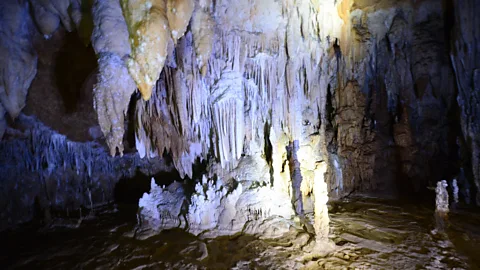 Belize Tourism Board
Belize Tourism BoardIn fact, Moyes believes that the Maya world parallels our own. "The story of what's happening to the Maya people is a real human story," she said. "It's a story that articulates what we are seeing now with climate change. After all, the Maya are simply praying for rain. Here in California, we do the same. We have signs on the highway that literally say 'Pray for Rain'."
After treading gently in the haunted footsteps of the Maya, we retrieved our shoes and followed Bol back through the underworld, and out into the blinding sunlight. As Bol grabbed my hand to help me clamber up rocks leading back to the jungle path, he echoed the same sentiment: "It was religious fervour that brought the Maya into these caves. But when things get desperate, and science fails us, we all start to pray."
---
Join more than three million BBC Travel fans by liking us on Facebook, or follow us on Twitter and Instagram.
If you liked this story, sign up for the weekly bbc.com features newsletter called "The Essential List". A handpicked selection of stories from BBC Future, Culture, Worklife and Travel, delivered to your inbox every Friday.
